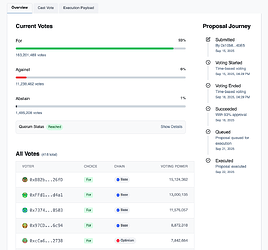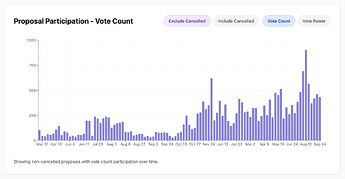Hey Moonwell community,
I’m excited to share the first look at a new governance dashboard built specifically for Moonwell by Wheelhaus Labs. You can check it out here:
![]() https://moonwell.wheelhaus.xyz/
https://moonwell.wheelhaus.xyz/
This dashboard is designed to make it easier for the community to explore proposals, track delegate activity, and understand voting power across Moonwell’s multichain governance system.
 Key Features
Key Features
Here’s what you’ll find on the dashboard today:
-
Detailed Proposal List & Proposal Pages
View every proposal with clear voting results, proposal details, and live vote stats.
-
Delegates Page
Browse all delegates with sorting options for all delegates and active delegates based on their recent vote history.
-
Delegate Profiles
Each delegate has a profile page with their bio, voting power breakdown, vote history, and a list of their delegators.
-
Stats & Analytics
Explore governance activity with charts showing proposal vote counts and total vote power used per proposal, helping you track engagement over time.
 Moonwell-Specific Features
Moonwell-Specific Features
This dashboard includes custom support for Moonwell’s unique governance system:
-
stkWell support baked directly into voting power breakdowns and calculations.
-
Multi-chain support across Moonbeam, Base, and Optimism, so you can track voting and delegation activity no matter which network it is on.
 Wheelhaus Organization Overview
Wheelhaus Organization Overview
Wheelhaus Labs is a newly formed company focused on building practical, reliable governance tools for DAOs.
Led by Carl Gocht, a full-stack developer with over 10 years of experience—including 4 years dedicated to DAO governance—Wheelhaus brings deep technical knowledge and firsthand experience delivering products for decentralized communities.
Previously, I worked at Boardroom and Agora, helping to build governance dashboards and data tools for large decentralized ecosystems.
 Contact Information
Contact Information
Name: Carl Gocht
Email: carl@wheelhaus.xyz
Telegram: @carlg_devcarlg_dev
I’d love for you all to take a look, give feedback, and let me know what features you’d like to see next. This is just the first version, and my goal is to make Moonwell governance more transparent, accessible, and community-driven.
Looking forward to your thoughts, and there is lots more to come soon!
— Carl






